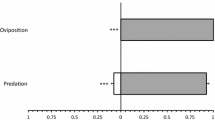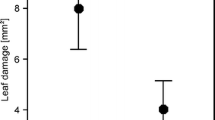Abstract
Lepthyphantes tenuis, a small sheet-webbuilding linyphiid spider is one of the most abundant spider species of cereal fields in Europe. In the present study we examined the process of web-site selection and web-site tenacity by adult females of this species in a winter wheat field. Spiders were selective in their choice of web-site. Different immigration rates into various manipulated web-sites, in field and laboratory, suggested that structural support and suitable micro-climate (high humidity) are the most important factors in the selection. Small holes dug in the ground were the most favoured web-sites. Web-site occupation was influenced by the presence of other conspecific spiders. Territorial contests occurred between spiders attempting to occupy the same web, these almost invariably led to the take-over of the web when the intruder was heavier. Interference, but also a certain level of tolerance, between spiders within the same web-site but in different webs was suggested by direct and indirect evidence. Many holes supported two or even three spiders in vertically stratified webs. Leaving probability of marked spiders was significantly higher in multiply occupied holes than in holes with a single web. Comparison with the results of a no-interference stochastic model showed that multiple occupancy in nature is less frequent than predicted by the model. There was further evidence for weak extra-web-interference between spiders in that multiple occupancy was even less frequent and overall occupancy was lower in web-sites which were packed close to each other. However, a level of tolerance for crowding is shown by the fact that closely packed hole colonies supported a spider density 13 times higher than in natural web-sites in the field. A marking experiment was carried out to gain information on web-site tenacity (i.e. the length of time a spider spends in a web-site) and abandonment. The average duration of tenacity was less than 2 days. A random loss function gave a good fit to the tenacity distribution and suggested that spiders abandoned web-sites randomly with a fixed leaving probability of c. 0.5. Individual webs were often used consecutively by more than one spider, and some spiders built more than one web in the same web-site. Calculations showed that abandonment is the most frequent leaving mode, while take-over by contest between spiders and disappearance due to destruction were some-what less frequent and equally likely modes of ending tenacity. It is suggested that the apparent contradiction between the selectiveness and competitiveness of spiders for web-sites and the relatively short tenacity observed can be resolved by hypothesising that spiders leave websites soon because they apply the strategy of spreading risk: spiders by frequently moving from one web-site to another distribute their reproductive efforts across several localities. This hypothesis is further supported by changes in web-site preference and ballooning behaviour at the onset of the reproductive stage in L. tenuis.
Similar content being viewed by others
References
Alderweireldt M (1994) Habitat manipulations increasing spider densities in agroecosystems: possibilities for biological control? J Appl Entomol 118:10–16
Baarlen P van, Sunderland KD, Topping CJ (1994) Eggsac parasitism of money spiders (Araneae: Linyphiidae) in cereals, with a simple method for estimating percentage parasitism of Erigone eggsacs by Hymenoptera. J Appl Entomol 118:217–223
Bristowe WS (1958) The world of spiders. Collins New Naturalist, London, pp 304
Churchfield S, Brown VK (1987) The trophic impact of small mammals in successional grasslands. Biol J Linn Soc 31:273–290
Colebourn PH (1974) The influence of habitat structure on the distribution of Araneus diadematus Clerck. J Anim Ecol 43:401–409
Den Boer PJ (1968) Spreading the risk and stabilisation of animal numbers. Biol Stat Wijster 136:165–194
Duffey E (1956) Aerial dispersal in a known spider population. J Anim Ecol 25:85–111
Duffey E (1966) Spider ecology and habitat structure (Arach., Araneae). Senck Biol 47:45–49
Duffey E (1968) An ecological analysis of the spider fauna of sand dunes. J Anim Ecol 37:641–674
Duffey E (1975) Habitat selection by spiders in man-made environments. In: Proceedings of the 6th International Arachnological Congress, Amsterdam, pp 53–67
Enders F (1976) Effects of prey capture, web destruction and habitat physiognomy on web-site tenacity of Argiope spiders (Araneidae). J Arachnol 3:75–82
Enders F (1977) Web-site selection by orb-web spiders, particularly Argiope aurantia Lucas. Anim Behav 25:694–712
Faber DB, Baylis JR (1993) Effects of body size on agonistic encounters between male jumping spiders (Araneae: Salticidae). Anim Behav 45:289–299
Field J (1992) Guild structure in solitary spider-hunting wasps (Hymenoptera: Pompilidae) compared with null model predictions. Ecol Entomol 17:198–208
Fitton MG, Shaw MR, Austin AD (1987) The Hymenoptera associated with spiders in Europe. Zool J Linn Soc 90:65–93
Ford MJ (1977) Ehergy cost of the predation strategy of the webspinning spider Lepthyphantes zimmermanni Bertkau (Linyphiidae). Oecologia 28:341–349
Fraser AM (1982) The role of spiders determining cereal aphid numbers. PhD thesis, University of East Anglia, England
Gillespie RG (1987) The mechanisms of habitat selection in longjawed orb-weaving spider Tetragnatha elongata (Araneae, Tetragnathidae). J Arachnol 15:81–90
Hallander H (1970) Prey, cannibalism and microhabitat selection in the wolf spiders Pardosa chelata O. F. Muller and P. pullata Clerck. Oikos 21:337–340
Hänggi A, Stöckli E, Nentwig W (1995) Habitats of Central European spiders. Misc Faun Helv 4:1–460
Hays SB, Hays KL (1959) Food habits of Solenopsis saevissima richteri Forel. J Econ Entomol 52:455–457
Heidger C (1988) Ecology of spiders inhabiting abandoned mammal burrows in South African savanna. Oecologia 76:303–306
Hengeveld R (1985) Methodology of explaining differences in dietary composition of carabid beetles by competition. Oikos 45:37–49
Hodge MA (1987) Agonistic interactions between female bowl and doily spiders (Araneae, Linyphiidae): owner biased outcomes. J Arachnol 15:241–247
Holopainen JK, Helenius J (1992) Gut contents of ground beetles (Coleoptera, Carabidae), and activity of these and other epigeal predators during an outbreak of Rhopalosiphum padi (Homoptera, Aphididae). Acta Agric Scand B Soil Plant Sci 42:57–61
Janetos AC (1982) Foraging tactics of two guilds of web-spinning spiders. Behav Ecol Sociobiol 10:19–27
Janetos AC (1984) Comparative ecology of two linyphiid spiders (Araneae, Linyphiidae). J Arachnol 11:315–322
Janetos AC (1986) Web-site selection: are we asking the right questions? In: Shear W (ed) Spiders: webs, behaviour and evolution. Stanford University Press, Stanford
Janssens J, DeClercq R (1990) Observations on Carabidae, Staphylinidae and Araneae as predators of cereal aphids in winter wheat. Med Fac Landbouww Rijksuniv Gent 55:471–475
Leclere J (1991) Optimal foraging strategy of the sheet-web spider Lepthyphantes flavipes under perturbation. Ecology 72:1267–1272
Leclere J, Blandin P (1991) L'importance des interactions dans une population de l'araignée Lepthyphantes flavipes (Blackwall) (Araneida: Linyphiidae) Can J Zool 69:2246–2249
Malcolm SB (1989) Disruption of web structure and predatory behaviour of a spider by plant derived chemical defences of an aposematic aphid. J Chem Ecol 15:1699–1716
McCullagh P, Nelder JA (1989) Generalized linear models. Chapman and Hall, London
Nyffeler M, Benz G (1988) Prey and predatory importance of micryphantid spiders in winter wheat fields and hay meadows. J Appl Entomol 105:190–197
Olive CW (1982) Behavioural response of a sit-and-wait predator to spatial variation in foraging gain. Ecology 63:912–920
Riechert SE (1974) The pattern of local web distribution in a desert spider: mechanisms and seasonal variation. J Anim Ecol 43:733–746
Riechert SE (1984) Games spiders play. III. Cues underlying context-associated changes in agonistic behaviour. Anim Behav 32:1–15
Riechert SE, Hedrick AV (1990) Levels of predation and genetically based anti-predator behavior in the spider, Agelenopsis aperta. Anim Behav 40:679–687
Riechert SE, Tracy CR (1975) Thermal balance and prey availability: bases for a model relating web-site characteristics to spider reproductive success. Ecology 56:265–284
Rypstra AL (1983) The importance of food and space in limiting web-spider densities; a test using field enclosures. Oecologia 59:312–316
Schaefer M (1978) Some experiments on the regulation of population density in the spider Floronia bucculenta (Araneidae: Linyphiidae). Symp Zool Soc Lond 42:203–210
Sopp PI (1987) Quantification of predation by polyphagous predators on Sitobion avenae (Homoptera: Aphididae) in winter wheat using ELISA. PhD thesis, University of Southampton, England
Sunderland KD (1987) Spiders and cereal aphids in Europe. Bull SROP/WPRS 10:82–102
Sunderland KD (1996) Studies on the population ecology of Lepthyphantes tenuis (Araneae: Linyphiidae) in cereals. Bull SROP/WPRS (in press)
Sunderland KD, Topping CJ (1993) The spatial dynamics of linyphiid spiders in winter wheat. Mem Queensland Mus 33:639–644
Sunderland KD, Fraser AM, Dixon AFG (1986a) Distribution of linyphiid spiders in relation to capture of prey in cereal fields. Pedobiologia 29:367–375
Sunderland KD, Fraser AM, Dixon AFG (1986b) Field and laboratory studies on money spiders (Linyphiidae) as predators of cereal aphids. J Appl Ecol 23:433–447
Sunderland KD, Ellis SJ, Weiss A, Topping CJ, Long S (1994) The effects of polyphagous predators on spiders and mites in cereal fields. In: Proceedings of the BCPC Conference — Pests and diseases 1994, BCPC, Farnham, UK, pp 1151–1156
Sunderland KD, Topping CJ, Ellis SJ, Long S, Laak S van der, Else M (1995) Reproduction and survival of linyphiid spiders in UK cereals. Acta Jutlandica (in press)
Thornhill WA (1983) The distribution and probable importance of linyphiid spiders living on the soil surface of sugar-beet fields. Bull Br Arachnol Soc 6:127–136
Toft S (1987) Microhabitat identity of two species of sheet-web spiders: field experimental demonstration. Oecologia 72:216–220
Toft S (1988) Interference by web take-over in sheet-web spiders. In: Haupt J (ed) XI Europaeisches Arachnologisches Colloquium, Berlin, Technische Universität Berlin, Dokumentation Kongresse und Tagungen, Berlin, pp 48–59
Toft S (1995a) Value of the aphid Rhopalosiphum padi as food for cereal spiders. J Appl Ecol 32:552–560
Toft S (1995b) Indicators of prey quality for arthropod predators. Acta Jutlandica (in press)
Tolbert WW (1975) Predator avoidance behaviors and web defensive structures in the orb weavers Argiope aurantia and Argiope trifasciata (Araneae: Araneidae). Psyche 82:29–52
Topping CJ (1993) Behavioural responses of three linyphiid spiders to pitfall traps. Entomol Exp Appl 68: 287–293
Vollrath F (1985) Web spider's dilemma: a risky move or site dependent growth. Oecologia 68: 69–72
Vollrath F (1992) Analysis and interpretation of orb spider exploration and web-building behavior. Adv Stud Behav 21: 147–199
Weyman GS, Jepson P (1994) The effect of food supply on the colonisation of barley by aerially dispersing spiders (Araneae). Oecologia 100: 386–390
Weyman GS, Jepson P, Sunderland KD (1995) Do seasonal changes in numbers of aerially dispersing spiders reflect population density on the ground or variation in ballooning motivation? Oecologia 101: 487–493
Witt PN, Reed CF, Peakall DB (1968) A spider's web: problems in regulatory biology. Springer, Berlin Heidelberg New York
Author information
Authors and Affiliations
Corresponding author
Rights and permissions
About this article
Cite this article
Samu, F., Sunderland, K.D., Topping, C.J. et al. A spider population in flux: selection and abandonment of artificial web-sites and the importance of intraspecific interactions in Lephthyphantes tenuis (Araneae: Linyphiidae) in wheat. Oecologia 106, 228–239 (1996). https://doi.org/10.1007/BF00328603
Received:
Accepted:
Issue Date:
DOI: https://doi.org/10.1007/BF00328603




